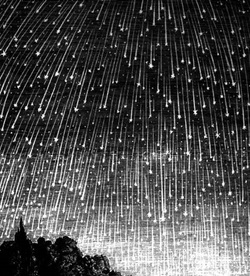
The image on the left depicts the Leonid meteor storm that occurred in Nov. of 1833. People were amazed according to the accounts at the time when an estimated 200,000 meteors fell per hour! Your average meteor shower averages at about 10-33 per hour. The sky must have looked like it was on fire. The Leonids occur every year around this time when Earth passes through the debris field or meteoroids left by Comet Swift-Tuttle's tail. Most meteoroids are the size of dust grains and hit the Earth's atmosphere at around 70 km/s - creating a flash of light. The Leonids usually follow a 33- year peak cycle. The last peak occurred in 1999 - 2000 - 2001 where over 3,000 meteors per hour were observed.
Try & catch the Leonid meteor shower the nights of Nov. 16-20th - 2012. Meteors per hour (or ZHR) are tough to predict but two-peaks are expected. The first "peak" will occur on Nov. 17th at 4:43 am Eastern Standard Time (EST) when a whopping 10 ZHR are predicted. (I'm not personally holding out for that one.) The next peak with up to 15 ZHR occurs around 12:30 am EST Nov. 20th (which seems more reasonable). Although its a fair bet you'll see some meteors - if the weather is clear - try and observe in a dark area. You can still see a few meteor flashes if you live in the city/suburbs though. Naked eye & binoculars are OK but a telescope isn't necessary. Look for the constellation Leo - located just under the Big Dipper.
Try & catch the Leonid meteor shower the nights of Nov. 16-20th - 2012. Meteors per hour (or ZHR) are tough to predict but two-peaks are expected. The first "peak" will occur on Nov. 17th at 4:43 am Eastern Standard Time (EST) when a whopping 10 ZHR are predicted. (I'm not personally holding out for that one.) The next peak with up to 15 ZHR occurs around 12:30 am EST Nov. 20th (which seems more reasonable). Although its a fair bet you'll see some meteors - if the weather is clear - try and observe in a dark area. You can still see a few meteor flashes if you live in the city/suburbs though. Naked eye & binoculars are OK but a telescope isn't necessary. Look for the constellation Leo - located just under the Big Dipper.
 RSS Feed
RSS Feed
